+ Open data
Open data
- Basic information
Basic information
| Entry | Database: PDB / ID: 3ja9 | ||||||
|---|---|---|---|---|---|---|---|
| Title | Structure of native human PCNA | ||||||
 Components Components | Proliferating cell nuclear antigen | ||||||
 Keywords Keywords |  DNA BINDING PROTEIN / DNA BINDING PROTEIN /  DNA / DNA /  REPLICATION / PROCESSIVITY / REPLICATION / PROCESSIVITY /  ONCOGENE / DNA-BINDING SYSTEMIC LUPUS ERYTHEMATOSUS ONCOGENE / DNA-BINDING SYSTEMIC LUPUS ERYTHEMATOSUS | ||||||
| Function / homology |  Function and homology information Function and homology informationpositive regulation of deoxyribonuclease activity / dinucleotide insertion or deletion binding / PCNA-p21 complex / mitotic telomere maintenance via semi-conservative replication / purine-specific mismatch base pair DNA N-glycosylase activity / positive regulation of DNA-directed DNA polymerase activity / MutLalpha complex binding /  nuclear lamina / Polymerase switching / Telomere C-strand (Lagging Strand) Synthesis ...positive regulation of deoxyribonuclease activity / dinucleotide insertion or deletion binding / PCNA-p21 complex / mitotic telomere maintenance via semi-conservative replication / purine-specific mismatch base pair DNA N-glycosylase activity / positive regulation of DNA-directed DNA polymerase activity / MutLalpha complex binding / nuclear lamina / Polymerase switching / Telomere C-strand (Lagging Strand) Synthesis ...positive regulation of deoxyribonuclease activity / dinucleotide insertion or deletion binding / PCNA-p21 complex / mitotic telomere maintenance via semi-conservative replication / purine-specific mismatch base pair DNA N-glycosylase activity / positive regulation of DNA-directed DNA polymerase activity / MutLalpha complex binding /  nuclear lamina / Polymerase switching / Telomere C-strand (Lagging Strand) Synthesis / Processive synthesis on the lagging strand / nuclear lamina / Polymerase switching / Telomere C-strand (Lagging Strand) Synthesis / Processive synthesis on the lagging strand /  PCNA complex / Processive synthesis on the C-strand of the telomere / Removal of the Flap Intermediate / Mismatch repair (MMR) directed by MSH2:MSH3 (MutSbeta) / Mismatch repair (MMR) directed by MSH2:MSH6 (MutSalpha) / Polymerase switching on the C-strand of the telomere / Transcription of E2F targets under negative control by DREAM complex / Removal of the Flap Intermediate from the C-strand / PCNA complex / Processive synthesis on the C-strand of the telomere / Removal of the Flap Intermediate / Mismatch repair (MMR) directed by MSH2:MSH3 (MutSbeta) / Mismatch repair (MMR) directed by MSH2:MSH6 (MutSalpha) / Polymerase switching on the C-strand of the telomere / Transcription of E2F targets under negative control by DREAM complex / Removal of the Flap Intermediate from the C-strand /  replisome / response to L-glutamate / replisome / response to L-glutamate /  histone acetyltransferase binding / leading strand elongation / DNA polymerase processivity factor activity / replication fork processing / G1/S-Specific Transcription / response to dexamethasone / nuclear replication fork / SUMOylation of DNA replication proteins / histone acetyltransferase binding / leading strand elongation / DNA polymerase processivity factor activity / replication fork processing / G1/S-Specific Transcription / response to dexamethasone / nuclear replication fork / SUMOylation of DNA replication proteins /  estrous cycle / PCNA-Dependent Long Patch Base Excision Repair / estrous cycle / PCNA-Dependent Long Patch Base Excision Repair /  mismatch repair / cyclin-dependent protein kinase holoenzyme complex / mismatch repair / cyclin-dependent protein kinase holoenzyme complex /  translesion synthesis / positive regulation of DNA replication / response to cadmium ion / translesion synthesis / positive regulation of DNA replication / response to cadmium ion /  DNA polymerase binding / DNA polymerase binding /  base-excision repair, gap-filling / positive regulation of DNA repair / epithelial cell differentiation / Translesion synthesis by REV1 / Translesion synthesis by POLK / Translesion synthesis by POLI / Gap-filling DNA repair synthesis and ligation in GG-NER / TP53 Regulates Transcription of Genes Involved in G2 Cell Cycle Arrest / base-excision repair, gap-filling / positive regulation of DNA repair / epithelial cell differentiation / Translesion synthesis by REV1 / Translesion synthesis by POLK / Translesion synthesis by POLI / Gap-filling DNA repair synthesis and ligation in GG-NER / TP53 Regulates Transcription of Genes Involved in G2 Cell Cycle Arrest /  replication fork / male germ cell nucleus / replication fork / male germ cell nucleus /  liver regeneration / nuclear estrogen receptor binding / Recognition of DNA damage by PCNA-containing replication complex / Termination of translesion DNA synthesis / Translesion Synthesis by POLH / HDR through Homologous Recombination (HRR) / Dual Incision in GG-NER / liver regeneration / nuclear estrogen receptor binding / Recognition of DNA damage by PCNA-containing replication complex / Termination of translesion DNA synthesis / Translesion Synthesis by POLH / HDR through Homologous Recombination (HRR) / Dual Incision in GG-NER /  receptor tyrosine kinase binding / cellular response to hydrogen peroxide / Dual incision in TC-NER / Gap-filling DNA repair synthesis and ligation in TC-NER / cellular response to UV / cellular response to xenobiotic stimulus / response to estradiol / E3 ubiquitin ligases ubiquitinate target proteins / receptor tyrosine kinase binding / cellular response to hydrogen peroxide / Dual incision in TC-NER / Gap-filling DNA repair synthesis and ligation in TC-NER / cellular response to UV / cellular response to xenobiotic stimulus / response to estradiol / E3 ubiquitin ligases ubiquitinate target proteins /  heart development / damaged DNA binding / heart development / damaged DNA binding /  chromosome, telomeric region / chromosome, telomeric region /  nuclear body / nuclear body /  centrosome / centrosome /  chromatin binding / chromatin binding /  chromatin / protein-containing complex binding / negative regulation of transcription by RNA polymerase II / chromatin / protein-containing complex binding / negative regulation of transcription by RNA polymerase II /  enzyme binding / extracellular exosome / enzyme binding / extracellular exosome /  nucleoplasm / identical protein binding / nucleoplasm / identical protein binding /  nucleus nucleusSimilarity search - Function | ||||||
| Biological species |   Homo sapiens (human) Homo sapiens (human) | ||||||
| Method |  ELECTRON MICROSCOPY / ELECTRON MICROSCOPY /  single particle reconstruction / single particle reconstruction /  negative staining / Resolution: 22 Å negative staining / Resolution: 22 Å | ||||||
 Authors Authors | Lau, W.C.Y. / Li, Y. / Zhang, Q. / Huen, M.S.Y. | ||||||
 Citation Citation |  Journal: Sci Rep / Year: 2015 Journal: Sci Rep / Year: 2015Title: Molecular architecture of the Ub-PCNA/Pol η complex bound to DNA. Authors: Wilson C Y Lau / Yinyin Li / Qinfen Zhang / Michael S Y Huen /  Abstract: Translesion synthesis (TLS) is the mechanism by which DNA polymerases replicate through unrepaired DNA lesions. TLS is activated by monoubiquitination of the homotrimeric proliferating cell nuclear ...Translesion synthesis (TLS) is the mechanism by which DNA polymerases replicate through unrepaired DNA lesions. TLS is activated by monoubiquitination of the homotrimeric proliferating cell nuclear antigen (PCNA) at lysine-164, followed by the switch from replicative to specialized polymerases at DNA damage sites. Pol η belongs to the Y-Family of specialized polymerases that can efficiently bypass UV-induced lesions. Like other members of the Y-Family polymerases, its recruitment to the damaged sites is mediated by the interaction with monoubiquitinated PCNA (Ub-PCNA) via its ubiquitin-binding domain and non-canonical PCNA-interacting motif in the C-terminal region. The structural determinants underlying the direct recognition of Ub-PCNA by Pol η, or Y-Family polymerases in general, remain largely unknown. Here we report a structure of the Ub-PCNA/Pol η complex bound to DNA determined by single-particle electron microscopy (EM). The overall obtained structure resembles that of the editing PCNA/PolB complex. Analysis of the map revealed the conformation of ubiquitin that binds the C-terminal domain of Pol η. Our present study suggests that the Ub-PCNA/Pol η interaction requires the formation of a structured binding interface, which is dictated by the inherent flexibility of Ub-PCNA. | ||||||
| History |
|
- Structure visualization
Structure visualization
| Movie |
 Movie viewer Movie viewer |
|---|---|
| Structure viewer | Molecule:  Molmil Molmil Jmol/JSmol Jmol/JSmol |
- Downloads & links
Downloads & links
- Download
Download
| PDBx/mmCIF format |  3ja9.cif.gz 3ja9.cif.gz | 153.7 KB | Display |  PDBx/mmCIF format PDBx/mmCIF format |
|---|---|---|---|---|
| PDB format |  pdb3ja9.ent.gz pdb3ja9.ent.gz | 126.7 KB | Display |  PDB format PDB format |
| PDBx/mmJSON format |  3ja9.json.gz 3ja9.json.gz | Tree view |  PDBx/mmJSON format PDBx/mmJSON format | |
| Others |  Other downloads Other downloads |
-Validation report
| Arichive directory |  https://data.pdbj.org/pub/pdb/validation_reports/ja/3ja9 https://data.pdbj.org/pub/pdb/validation_reports/ja/3ja9 ftp://data.pdbj.org/pub/pdb/validation_reports/ja/3ja9 ftp://data.pdbj.org/pub/pdb/validation_reports/ja/3ja9 | HTTPS FTP |
|---|
-Related structure data
| Related structure data |  6339MC 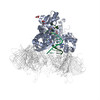 3jaaC M: map data used to model this data C: citing same article ( |
|---|---|
| Similar structure data |
- Links
Links
- Assembly
Assembly
| Deposited unit | 
|
|---|---|
| 1 |
|
- Components
Components
| #1: Protein |  / PCNA / Cyclin / PCNA / CyclinMass: 28795.752 Da / Num. of mol.: 3 Source method: isolated from a genetically manipulated source Source: (gene. exp.)   Homo sapiens (human) / Gene: PCNA / Production host: Homo sapiens (human) / Gene: PCNA / Production host:   ESCHERICHIA COLI (E. coli) / Strain (production host): BL21(DE3) / References: UniProt: P12004 ESCHERICHIA COLI (E. coli) / Strain (production host): BL21(DE3) / References: UniProt: P12004#2: Water | ChemComp-HOH / |  Water Water |
|---|
-Experimental details
-Experiment
| Experiment | Method:  ELECTRON MICROSCOPY / Number of used crystals: 1 ELECTRON MICROSCOPY / Number of used crystals: 1 |
|---|---|
| EM experiment | Aggregation state: PARTICLE / 3D reconstruction method:  single particle reconstruction single particle reconstruction |
- Sample preparation
Sample preparation
| Component | Name: Ub-PCNA/Pol eta/DNA / Type: COMPLEX Details: Monomeric catalytic core of Pol eta binds to one homotrimeric Ub-PCNA Synonym: Monoubiquitinated PCNA |
|---|---|
| Molecular weight | Value: 0.2 MDa / Experimental value: YES |
| Buffer solution | pH: 8 / Details: 50mM Tris-HCl, 5mM MgCl2 |
| Specimen | Embedding applied: NO / Shadowing applied: NO / Staining applied : YES / Vitrification applied : YES / Vitrification applied : NO : NODetails: 50mM Tris-HCl, 5mM MgCl2 (Stain Details Grids with adsorbed protein floated on two 20 ul drops of 2% w/v uranyl acetate solution for 30 seconds) |
| EM staining | Type: NEGATIVE / Material: Uranyl Acetate |
| Specimen support | Details: Continuous carbon coated copper grids (Ted Pella), glow-discharged for 30 seconds |
- Electron microscopy imaging
Electron microscopy imaging
| Microscopy | Model: JEOL 2010 / Date: Nov 12, 2014 |
|---|---|
| Electron gun | Electron source : LAB6 / Accelerating voltage: 200 kV / Illumination mode: FLOOD BEAM : LAB6 / Accelerating voltage: 200 kV / Illumination mode: FLOOD BEAM |
| Electron lens | Mode: BRIGHT FIELD Bright-field microscopy / Nominal magnification: 50000 X / Camera length: 0 mm Bright-field microscopy / Nominal magnification: 50000 X / Camera length: 0 mm |
| Specimen holder | Specimen holder model: SIDE ENTRY, EUCENTRIC / Tilt angle max: 0 ° / Tilt angle min: 0 ° |
| Image recording | Electron dose: 18 e/Å2 / Film or detector model: GATAN ULTRASCAN 4000 (4k x 4k) |
- Processing
Processing
| EM software |
| ||||||||||||
|---|---|---|---|---|---|---|---|---|---|---|---|---|---|
CTF correction | Details: Particles | ||||||||||||
| Symmetry | Point symmetry : C1 (asymmetric) : C1 (asymmetric) | ||||||||||||
3D reconstruction | Method: Projection matching / Resolution: 22 Å / Resolution method: FSC 0.143 CUT-OFF / Num. of particles: 7330 / Details: (Single particle--Applied symmetry: C1) / Num. of class averages: 227 / Symmetry type: POINT | ||||||||||||
| Atomic model building | Protocol: RIGID BODY FIT / Space: REAL / Details: REFINEMENT PROTOCOL--RIGID BODY | ||||||||||||
| Atomic model building | PDB-ID: 1VYM | ||||||||||||
| Refinement step | Cycle: LAST
|
 Movie
Movie Controller
Controller



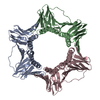
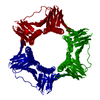

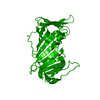
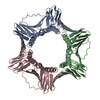







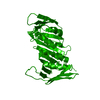
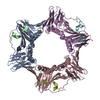
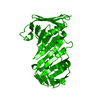
 PDBj
PDBj


















